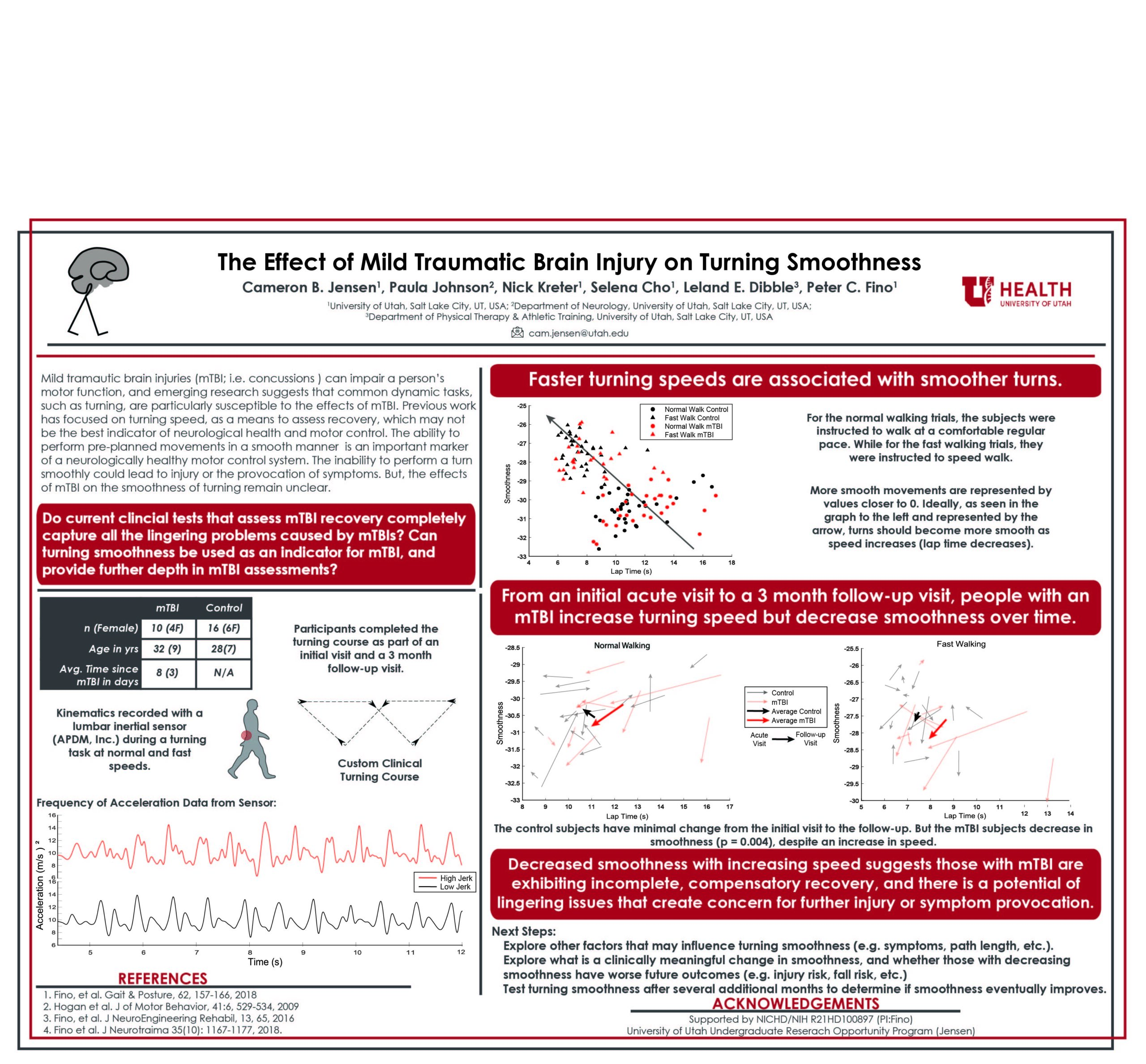Presenter Name: Cameron Jensen
Description
Purpose: Mild traumatic brain injuries (mTBIs; i.e. concussions) can impair a person's motor function, and lead to worse static balance than healthy individuals (Haran, 2016), and emerging research suggests that more dynamic tasks, such as turning, are particularly susceptible to the effects of mTBI (Fino, 2016, 2018a). While previous work has focused on speed and balance during turning (Fino, 2016, 2018a), the smoothness of a turn may also be important; the ability to perform pre-planned movements in a smooth, non-jerky manner is an important marker of a neurologically healthy motor control (Hogan, 2009). Smoothness is a relevant and valid way to quantify movement quality in people with impaired functional mobility, such as individuals with an mTBI, and it can be a good indicator of pathology (Beck, 2018; Pinto, 2019). As the effects of mTBI on the smoothness of turning remain unclear, this study sought to examine the acute and longitudinal effects of mTBI on movement smoothness during turning. We hypothesized that those with an mTBI would exhibit less smooth turns, and smoothness would improve as individuals recovered from their mTBI.
Methods: As part of a larger IRB-approved protocol, 11 healthy controls and 10 mTBI subjects walked around a turning course for 140 seconds after providing informed written consent. The turning course was made up of turns of varying angles. Participants completed three separate conditions: single-task, dual-task (turning while simultaneously counting down by 3's), and fast walking. Each subject was tested at an acute time point (within 2 weeks of receiving an mTBI) and then tested again three months later. Kinematic data was recorded from inertial measurement units (IMUs), and smoothness of axial rotation was quantified using log dimensionless jerk from the angular velocity data in the transverse (yaw) plane. Movements with less jerk are described as being smoother. For each of the three conditions, comparisons were made, in the form of t-tests, between the controls' two visits, between the mTBI subjects' two visits, and between the controls and mTBI subjects at each visit.
Results: During the single task condition, participants with mTBI exhibited less smooth turns at the follow-up visit compared to the acute visit (Acute mean (SD): -30.18 (0.75) a.u.; Follow-up mean (SD): -30.73 (0.88) a.u. ; p=0.004). No other significant results were found during the preliminary analysis.
Conclusions : The decreased smoothness over time was the opposite of our hypothesis, but these results may indicate that people with mTBI prioritize smoothness initially to avoid provoking symptoms. Alternatively, smoother turns in those with acute mTBI may be due to slower turning speeds; future work will consider turning speed as a covariate to account for this potential confounding factor.
Conclusions : The decreased smoothness over time was the opposite of our hypothesis, but these results may indicate that people with mTBI prioritize smoothness initially to avoid provoking symptoms. Alternatively, smoother turns in those with acute mTBI may be due to slower turning speeds; future work will consider turning speed as a covariate to account for this potential confounding factor.
University / Institution: University of Utah
Type: Poster
Format: In Person
Presentation #A73
SESSION A (9:00-10:30AM)
Area of Research: Health & Medicine
Email: u1053842@utah.edu
Faculty Mentor: Peter Fino

